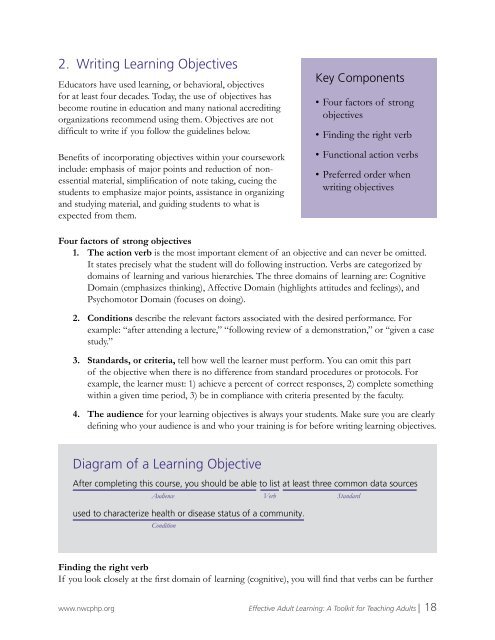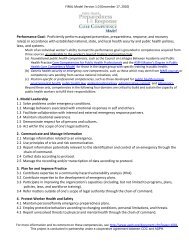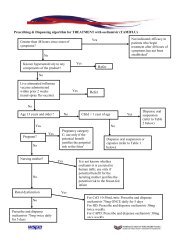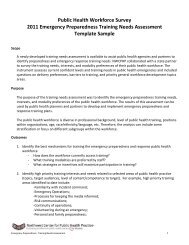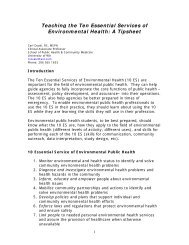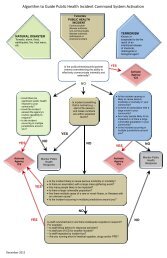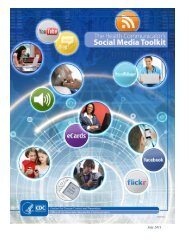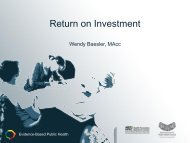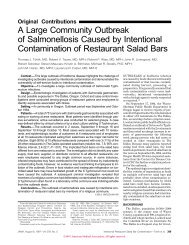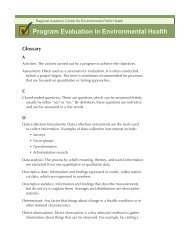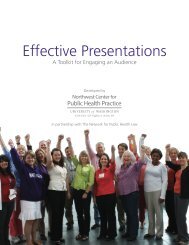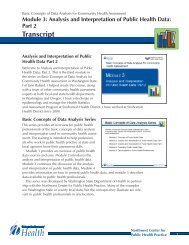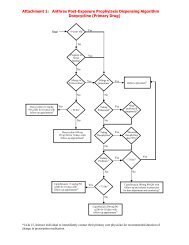Effective Adult Learning - Northwest Center for Public Health Practice
Effective Adult Learning - Northwest Center for Public Health Practice
Effective Adult Learning - Northwest Center for Public Health Practice
You also want an ePaper? Increase the reach of your titles
YUMPU automatically turns print PDFs into web optimized ePapers that Google loves.
2. Writing <strong>Learning</strong> Objectives<br />
Educators have used learning, or behavioral, objectives<br />
<strong>for</strong> at least four decades. Today, the use of objectives has<br />
become routine in education and many national accrediting<br />
organizations recommend using them. Objectives are not<br />
difficult to write if you follow the guidelines below.<br />
Benefits of incorporating objectives within your coursework<br />
include: emphasis of major points and reduction of nonessential<br />
material, simplification of note taking, cueing the<br />
students to emphasize major points, assistance in organizing<br />
and studying material, and guiding students to what is<br />
expected from them.<br />
Key Components<br />
• Four factors of strong<br />
objectives<br />
• Finding the right verb<br />
• Functional action verbs<br />
• Preferred order when<br />
writing objectives<br />
Four factors of strong objectives<br />
1. The action verb is the most important element of an objective and can never be omitted.<br />
It states precisely what the student will do following instruction. Verbs are categorized by<br />
domains of learning and various hierarchies. The three domains of learning are: Cognitive<br />
Domain (emphasizes thinking), Affective Domain (highlights attitudes and feelings), and<br />
Psychomotor Domain (focuses on doing).<br />
2. Conditions describe the relevant factors associated with the desired per<strong>for</strong>mance. For<br />
example: “after attending a lecture,” “following review of a demonstration,” or “given a case<br />
study.”<br />
3. Standards, or criteria, tell how well the learner must per<strong>for</strong>m. You can omit this part<br />
of the objective when there is no difference from standard procedures or protocols. For<br />
example, the learner must: 1) achieve a percent of correct responses, 2) complete something<br />
within a given time period, 3) be in compliance with criteria presented by the faculty.<br />
4. The audience <strong>for</strong> your learning objectives is always your students. Make sure you are clearly<br />
defining who your audience is and who your training is <strong>for</strong> be<strong>for</strong>e writing learning objectives.<br />
Diagram of a <strong>Learning</strong> Objective<br />
After completing this course, you should be able to list at least three common data sources<br />
Audience Verb Standard<br />
used to characterize health or disease status of a community.<br />
Condition<br />
Finding the right verb<br />
If you look closely at the first domain of learning (cognitive), you will find that verbs can be further<br />
www.nwcphp.org <strong>Effective</strong> <strong>Adult</strong> <strong>Learning</strong>: A Toolkit <strong>for</strong> Teaching <strong>Adult</strong>s | 18


